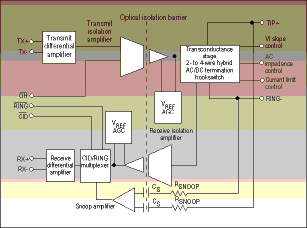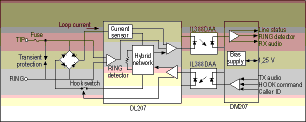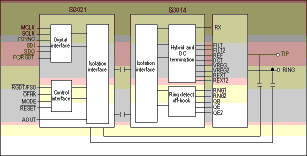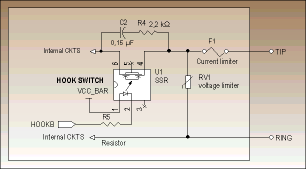
Embedded communications applications, such as credit-card verification, transferring medical data (biometrics), payphones, and cable and satellite television, connect either directly to another modem or through the Internet. For such embedded modem applications, does the designer use a modem module or card, which can sometimes cost more than the modem in your PC, or else build a custom modem from the ICs presently available at a reasonable cost?
Direct-access arrangements are crucial to successful embedded-modem designs
If more than a few modems are necessary, it is usually worth designing the modem as part of the product - either as a subassembly for use in a number of different applications, or embedded in the design itself. The cost of obtaining certification for FCC Parts 68 and 15 is quickly amortised if any significant volume production is planned. The modem data-pump functions, or the part of the modem that does the modulation and demodulation, is taken care of by the modem IC. Even the firmware for the modem command interface and control can be part of the modem IC that is employed.
These days, in nearly all cases, the only real challenge in modem design is the design of the direct access arrangement (DAA). This is the piece of the design that couples the telephone network to the analog connections of the modem and provides protection to the network. Prepackaged DAAs are available. Although relatively easy to use, the cost can be quite high because these are really hybrids or modules containing many components. They can easily exceed the cost of the rest of the modem and negate any advantage to including a modem as part of an embedded design. The most economical way is to make the DAA a part of the total modem design.
Currently, three standards exist that cover the requirements for DAAs in most countries worldwide. In North America, FCC Part 68 is the standard; in most of Europe, ETSI has defined a standard called CTR-21, while JATE defines the standards for Japan. Most other countries have standards falling within one of these groups. If a product can meet all of these standards, then it will probably work anywhere.
Originally, the Public Switched Telephone Network (PSTN) was designed for voice telephones. As new devices arrived (answering machines, faxes) they were/are required to have compatible electrical characteristics like a telephone. Most devices that use the PSTN derive power from some source other than the telephone network, so as not to interfere with normal network operation. The purpose of the DAA is to give the same benign connection.
DAA isolation design criteria: Several functions must be provided. Arguably, the most critical function is the high-voltage isolation of the modem circuitry from the telephone network. The choice of voltage-isolation method will often impact how most of the other DAA functions will be supported. Now, several techniques are used to achieve the high-voltage isolation. Traditionally, a telecom coupling transformer was mainly used, but capacitors and optocoupler-based techniques are also becoming popular.
In any DAA design, layout is a critical factor. Line-side components should be laid out so that there is a definable space between the components on the line side and those on the modem side. Any parts that bridge these two zones should physically straddle this barrier. Also, no ground or power plane should ever be allowed under the line-side components.
First, it is probably worth discussing the network and what interfacing to it requires. The US telephone network supplies between 20 and 100 mA of DC current on a PSTN line as a way of telling if a line is 'on-hook' or 'off-hook'. If the network senses current flow above a threshold, then it sends a dial tone and the user can begin to dial. For low-speed modem applications in the US, this DC current traditionally passes through the telecom transformer's primary winding, which has a DC resistance of 120 Ohm or so, and an AC impedance of 600 Ohm. In higher-speed modems, 9600 bps and above, the transformer is usually AC-coupled, and this current is shunted by a solid-state circuit that supplies the proper DC load for the offhook condition. This is needed when using better quality transformers required at higher data rates. Although transformers are considered old technology in some applications, are any alternatives really better? The selection of the isolation technology will determine how many, and how simply, the other DAA functions are performed. Let us take a look at isolation methods.

Optical isolation
Optocouplers have been used for a few years, primarily in small-footprint designs such as PCMCIA modems. But keep in mind that opto-based products can use different architectures. For example, C.P. Clare includes the optocouplers and most of the other required circuitry in a single package (Figure 1). In contrast, Infineon employs two discrete optocouplers (IL388DAA), plus a lineside (DL207) and a modem-side (DM207) IC (Figure 2). With either, the optocoupler is used in the linear mode - ie the transmit and receive signals are used to modulate an opto-emitter. On the transmit side, a second opto-receiver is used in the feedback path of the opto-emitter's driver to improve signal linearity to the opto-receiver on the other side of the isolation barrier.

Optocoupler-based DAAs have been used in designs supporting V.90 (or 56 kbits/s), so performance is not a limitation of this technique. But there can be some layout sensitivities. In present Clare-based DAAs, caller ID and ring detection are accomplished with a separate path from the PSTN to the modem using two high-voltage (2 kV) capacitors for isolation. Surface-mount versions of these special capacitors tend to be somewhat costly. Also, due to the multiple ICs required in the same package, manufacturing costs are somewhat higher. Infineon passes the control functions and Caller ID across the barrier through the same optocouplers used for the datapath, so additional external components are minimised. Both approaches employ discrete components in the PSTN interface to supply proper termination. More traditional transformer-based methods of isolation may be less expensive than opto-based ones. But if size is a major factor, then an opto-based solution may be a good choice.
Capacitive isolation
Also becoming more common is the use of high-voltage capacitors for the barrier. This method of isolation has taken on several forms, all of which have active circuitry on the telephone network side of the barrier. In some cases this also means that the DAA can be a more integral part of the modem itself, rather than a separate, more general-purpose circuit. Several techniques are employed to pass the data and control signals across the capacitors.
Modulate the analog data
One way is to modulate the analog data with a higher-frequency carrier and pass it across the capacitors to a receiver on the other side of the DAA. Think of it like an FM radio coupled through a capacitor. This approach was implemented by Krypton Isolation, now part of Silicon Laboratories. The company's chip-set designs, the Si3960G/GU each consist of two ICs and six coupling capacitors.
Nearly any modem datapump's analog pins can be connected to the modem-side interface IC. The network-side interfaces to the PSTN through external circuitry to provide the hook switch, along with AC and DC termination and protection. Using an analog-modulated carrier is an effective way to pass the signals, because demodulation becomes a simple task and yields low distortion of the original signal.
An additional path for control and status are included too, using another pair of capacitors. To keep EMI radiation to an allowable level (the modulated data carrier is a high-frequency signal), requires additional high-voltage capacitors. To achieve tolerance of high common-mode AC voltages between the modem and PSTN side, all the signalling across the barrier is accomplished differentially.
Another novel capacitive-isolation approach is to break apart the ADC and DAC functions - the CODEC sections - of the modem analog front end (AFE) and distribute the circuitry on either side of the isolation barrier. Only digital information is passed across the coupling capacitor. This capacitive DAA/AFE design concept was invented by the Communications Products Division of Silicon Systems (now TDK Semiconductor) in 1993, and then later adopted by Silicon Laboratories.

Capacitively coupled DAA/AFEs interface directly to the modem DSP and become an integral part of the modem system (Figure 3). The controller device sends control signals to the DAA/AFE over the same interface. Silicon Laboratories has both capacitively coupled separate DAAs, the Si303x family and complete 2400-, 14,4-, and 33,6 Kbps modem chipsets, the Si2400, Si2414 and Si2433, respectively. The downside of the separate DAA approach is that the designer must then provide a DSP chip with code to perform data-pump functions for the standards to be supported. This falls outside the realm of a turnkey modem for the nonDSP programmer and, therefore, is not a simple hardware addition.
Additionally, with a capacitive-isolation approach, problems sometimes occur with EMI from the high frequencies of the data signals as well as common-mode rejection sensitivities. Large high-voltage capacitors are needed between the modem ground and the PSTN low-side power to control noise and allow for a signal return path. This typically means between four and six high-voltage capacitors. When using surface-mount capacitors, this becomes fairly expensive compared to low data-rate, transformer-based designs. (Through-hole capacitors are available for much less cost.) For high-speed modems, this is less of an issue, because small, quality transformers themselves are expensive
Conexant, formerly Rockwell, offers another approach. It uses a combination of differential high-voltage capacitors for passing data and control, plus an inexpensive pulse transformer to power the PSTN side circuitry and supply the clock. This way, the modem can be in an on-hook state while the network-side AFE stays active.
Other DAA design considerations: The isolation methods are now clear, so other functions of the DAA must be addressed. In most cases, the chosen isolation method determines how the other DAA functions are provided.
All modems require some sort of protection in the connection to the PSTN. It consists of both overvoltage and over-current devices to keep the modem from failing in such a way that could compromise the isolation between the modem and PSTN. There needs to be a current-limiting device, such as a fuse, in series with at least one of the PSTN connections.
One of the newer products, the Polyswitch self-resetting fuse from Raychem (other manufacturers offer similar devices), has started to become popular. It is a polymer device with a conductive filler that heats up when too much current gets passed, and very quickly increases in resistance to limit current to low levels. The overvoltage protection can be one of a number of products, such as an MOV, gas-discharge device, or another newer solid-state device, the Sidactor from Teccor. All of these either go to a low impedance to clamp the fault voltage to some maximum level, or become a short circuit that then trips the current-limiting device. This protection varies from country to country depending on the regulations in force. More information is available through ETSI, the TIA, and the EIA.
Termination requirements
In all of the capacitive and optocoupled designs, PSTN termination requires external discrete components. Only the transformer-based DAA for US applications at 2400 bps and below do not need these circuits. The AC-termination requirements for the US and CTR-21-compliant countries use different loads when specifying the operating requirements. For the US, only a simple 600 Ohm resistor is necessary to terminate the modem when testing its operation. A complex RC network is needed for CTR-21 compliance. It consists of the parallel combination of a 150 nF capacitor and a 750 Ohm resistor in series with a 270 Ohm resistor. This means that for proper matching, a similar impedance characteristic must be reflected to the line.
For a transformer-based US modem, a simple resistor can be used between the modem transmit output and transformer. For a CTR-21-compliant modem, a network similar to the load is used to couple the transmit signal to the line. When using a nontransformer design, the AC impedance will also need to match the line load for compliance.
The different products explored in the isolation discussion use different methods to accomplish the termination - some involving both external and internal circuitry. This has been thought out for each design method, so it is merely a matter of following the manufacturer's recommended circuits to get the proper AC and DC characteristics.
A simple DAA usually includes the incoming ring detector and hookswitch relay, but it might also provide a number of other functions depending on the application. There may be circuitry to provide pulse dialling and support for Caller ID. If the modem will share the line with other telecom devices, or be used in the home, then it often requires line-in-use and parallel pick-up detection for safety reasons. Ring detection is accomplished differently with each isolation method. In transformer-based designs, the line reversal, line-in-use, and/or parallel pick-up can sometimes be combined to use the ring detect optocoupler for several purposes, although other functions still require additional circuitry.
The Caller ID is sent while the modem is still on hook, either after the first ring cycle or after a line reversal (DC voltage is reversed). Caller ID is performed in several of the isolation methods using a low-current state or 'snoop mode' to power up the line-side circuitry in a state that still keeps the current draw below the network's off-hook detection threshold. The reason that this is allowed varies according to regulations. In the US, more current can be taken during a ring cycle, which is when Caller ID is sent. In countries where Caller ID comes before the first ring cycle, more current can be drawn from the line during the CID interval.
US transformer-based DAAs can take advantage of the RC network or 'snubber' normally found across the hook switch to couple the Caller ID message to the transformer. Using a 2,2 kOhm resistor and a 0,15 µF capacitor, the snubber also supplies a path for Caller ID (Figure 4). With this approach, no additional parts are needed to switch in a signal path. Adding a switch and a capacitive path to get the caller ID message across the hook switch may be necessary for transformer-based DAAs in other countries.

Line-in-use and parallel pickup are features usually required in applications that will have a modem making unattended connections on a line shared with a telephone. The telephone should always have the highest priority on the network, so the modem should not try to make a call if the line is in use, and it should relinquish the line if another device picks up the same line. Not all of the listed isolation methods normally support these features.
If this is a requirement for an application, selecting the isolation method should take that into consideration. Also, in the case of the Infineon DAA, the output of a voltage-to-frequency converter represents the line voltage. To determine the line status, the modem or host must be able to use this signal as an indication of the line voltage. This requires a counter function capable of monitoring the line status during the on-hook period.
When deciding on the modem design, it is important to look at all of the variables before deciding on what approach to adopt. Make sure that you understand how all of the features you require are supported and where you need to concentrate your engineering. Make certain that all circuitry necessary to support the required features are accounted for when comparing technologies. Do not be enamored by 'new' techniques when 'old' technology, like the tried and true transformer, may be better suited for your application. See if the level of support from your modem and DAA suppliers is compatible with your requirements. Do not hesitate to ask DETAILED questions while exploring the proper way to use a vendor's products, especially in the area of the DAA, because that is where the certification testing will make or break the modem design. If you cannot get the level of support that you feel is needed, perhaps you chose the wrong vendor. Including a modem in your design should not be a painful process.
| Tel: | +27 11 458 9000 |
| Email: | [email protected] |
| www: | www.electrocomp.co.za |
| Articles: | More information and articles about Electrocomp |

© Technews Publishing (Pty) Ltd | All Rights Reserved